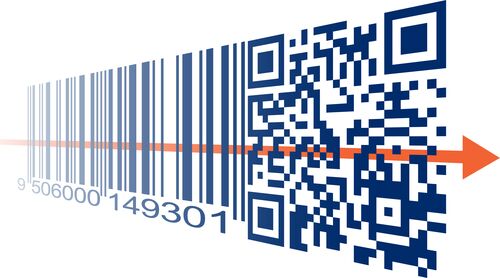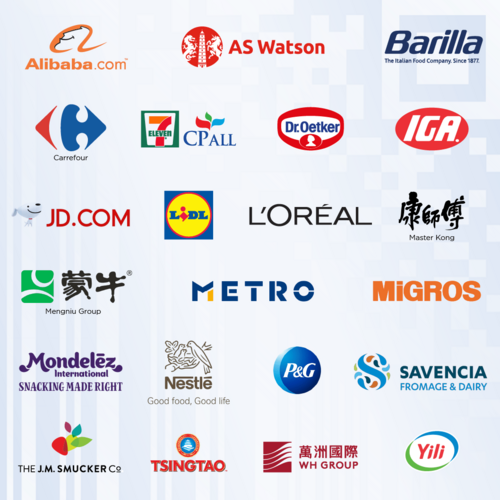Joint Industry Statement: QR codes powered by GS1 standards
Jun 26, 2024,
by GS1 Global - Category: QR Codes
Leading companies in the retail and consumer goods industries call for the transition to QR Codes with GS1 standards
50 years after the first barcode was scanned, 22 leaders from the world’s biggest companies – including Alibaba, Carrefour, IGA, JD.com, JM Smucker, Mondelēz, Lidl, L’Oréal, Nestlé, P&G and others – have come together and signed an Industry Global Joint Statement urging the transition to QR Codes powered by GS1.
The signatories of this letter join the members of the GS1 Management Board in declaring their support for the transition to QR Codes with GS1 standards.
Download the Industry Global Joint Statement and list of signatories.

Placing QR Codes with GS1 standards on product packages worldwide will enable manufacturers and retailers to provide new, powerful digital experiences, engaging consumers and shoppers as they interact with products— whether in store, at home or out in the world.
From GS1 barcodes to QR Codes with GS1 standards
This year marks the 50th anniversary of the first product barcode to be scanned in a grocery store. In the early 1970s, retailers and manufacturers worked together with GS1 - the global organisation for data standards - to adopt the barcode as the universal way to identify products. The GS1 barcode is used today on billions of products worldwide and is great for enabling many processes like scanning at checkout, category management, fulfillment in distribution centers, and much more.
Today, more than ever, consumers and regulatory bodies are demanding more product information, such as usage instructions, safety, ingredients, nutrition, certifications, recycling, etc. - and there is an ongoing need for enhanced product traceability through the supply chain to mitigate risks and improve customer service. However, the traditional barcode that has served us so well doesn’t have the capacity to support these future needs.
To meet these new demands, the consumer goods industry will be best served by transitioning to QR Codes with GS1 standards, as they can store extensive amounts of product information and are easily accessible via smartphones. This would open a range of new possibilities, providing all the information consumers need and desire, improving traceability and driving efficiencies through the supply chain, while still enabling scanning at check out.
Sunrise 2027 initiative
The signatories of this letter join the members of the GS1 Management Board in declaring their support for the transition to QR Codes with GS1 standards.

Download the Joint Statement
The companies of the GS1 Management Board aligned it would be essential for the overall success of the industry to transition to QR Codes with GS1 standards as an innovative and forward-looking response to today’s business and consumer needs. The aim of this initiative is that, by the end of 2027, QR Codes with GS1 standards should be widely adopted: used by manufacturers on their product packaging and retailers around the world having the ability to scan these barcodes at Point of Sale (POS).
For Sunrise 2027 to succeed, industry must once again come together to adopt a unified approach, requiring changes from both retailers and manufacturers.
We expect that this transition would happen gradually and believe that those that lead this transformation will be best positioned to unlock valuable new capabilities and provide more benefits to their customers, shoppers, and consumers.
Together, let’s start the transition to QR Codes with GS1 standards now!
This major industry shift has already begun, with pilots in 48 countries across all regions and representing 88% of the world’s GDP. This is a strong foundation, and a collective effort is now needed from the entire industry to make Sunrise 2027 happen:
• Manufacturers should start implementing QR Codes on product packages with GS1 data standards inside.
• Retailers should ensure POS scanners are equipped to read QR Codes with GS1 standards.
View the QR Code Endorsement Joint Statement Letter
How to Get Started: additional information on QR Codes with GS1 standards
For the Sunrise 2027 initiative to succeed, retailers and manufacturers would need to take the following key action:
- Retailers would need to ensure their POS systems are equipped with scanners capable of reading both traditional (one-dimensional/1D) barcodes and two-dimensional/2D barcodes (e.g., QR Codes and GS1 DataMatrix). This includes ensuring optical scanner hardware is in place—as well as the appropriate software and the process design to read 2D barcodes. Current trends indicate a promising trajectory towards achieving critical mass in this area by 2027 (>85%), with a significant majority of global retail POS systems already capable of reading 2D barcodes. The right technology, together with the right supply chain processes, will deliver traceability benefits for both retailers and manufacturers.
- Manufacturers would need to choose the most appropriate data carriers for their needs, either QR Codes (the most widely used and that can be read natively with smartphones) or GS1 DataMatrix (commonly used in healthcare), and determine what additional data to embed in the barcode—e.g., product expiry date, lot number, serial number, etc. Assessing the necessary technological and process changes is essential. For example, fresh foods using real-time labelling can soon incorporate expiration dates in their barcodes. In contrast, products with
pre-printed packaging will need advanced manufacturing technology to do the same. Finally, adoption of the GS1 Digital Link standard is also needed to direct consumers to an online product experience through a simple smartphone scan.
What industry leaders are saying
“Consumers demand more information about the products they’re purchasing, regulators require the disclosure of more information and there’s an ongoing need to more effectively track and trace products through the supply chain. We can resolve this with 2D barcodes with GS1 standards inside – a single barcode that has the power to provide all the information consumers need and desire, improve traceability through the supply chain, and scans at checkout.” Jon R. Moeller, Chairman of the Board, President and CEO, The Procter & Gamble Company
“The transition to the next generation 2D barcodes will be an epoch-making moment, just as the introduction of the barcode was. Our industry must do this together and together achieve the goal of exchanging relevant and trusted data with partners, authorities and above all consumers, who are increasingly interested in knowing everything about the products they buy. I believe that a data culture is crucial to increase the value of our company's relationship with consumers and the reputation of the entire industry”. Silvia Bagliani, VP & Managing Director Italy, Mondelēz International
“As our customers have become increasingly digitally-savvy, adopting QR Codes with GS1 standards inside is important in providing a seamless O+O (Offline plus Online) customer experience. These QR Codes enable customers to easily access detailed product information with a simple smartphone scan, empowering them to make more informed purchasing decisions. At AS Watson, we are delighted to support this transition, and I’m confident that it will unleash a wealth of new opportunities ahead.” Malina Ngai, Group CEO, AS Watson Group
Tags: Global Migration to 2D, GS1 powered QR codes, GS1 DataMatrix, #GS1Barcode50, #scanniversary